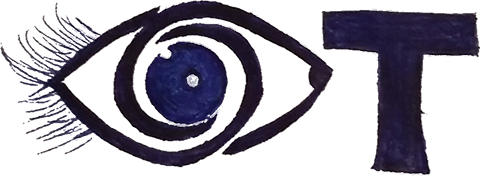Eccentric viewing or eccentric fixation is how an individual’s eyes look when using their patching of functioning vision outside of the macular which is known as Preferred Retinal Loci (PRL). The purpose of learning PRL is to optimize what remains of functional vision and to “look around” the presence of scotoma. This technique has shown to improve functional reading and ADL performance. However, learning to use this technique is difficult as each person is habitually trained to look centrally. Refer to loss of central vision for the effect of scotoma on vision.
Eccentric Viewing Training Sequencing
- The most important thing to address before teaching the eccentric viewing strategy is to increase the awareness of the client in regard to their scotoma.
- At the beginning of training, clients will need a central fixation cue that eventually fades out. This will progressively be replaced with verbal cueing (see next step).
- As the client practices eccentric viewing, verbal cues are needed for reassurance, encouragement, and reminder of the benefits and purpose of the technique used.
- Facilitate the training a more natural environment for increase carry over, without the use of central fixation cue.
- Once steps 1-4 are completed, the client is now ready to be evaluated by an optometrist for device evaluation.
- The client will be educated on the use of assistive devices recommended by an optometrist, this device will be modified as needed to optimize function and effective use.
- The client will now train to complete eccentric viewing with or without the recommended assistive device slowly weaning off of use.
- The client will then find the best eccentric viewing position.
The Clock Face Method
The occupational therapist will present a picture of a clock with a star in the middle. The OT will then ask the client which numbers are they able to see, or if they are able to see all the numbers are they able to see the center of the clock. This method is used to determine the location of the scotoma. This can assist in educating and explaining the center of the blind spot and demonstrating how it can be moved and optimize vision by looking “around” it. The following book contains worksheets to practice eccentric viewing: Wright, V., Watson, G. R. (1996). Learn to use your vision for reading. Lilburn, GS: Bear Consultants
Tangent Screen Method
This method can be used as an evaluation, education, and training tool for eccentric viewing. This method requires the use of a large felt board with a cross in the middle. The client is instructed to look at a letter that is sized enough for the client to recognize. The first positioning of the viewing target is in the center of the large cross, the client is then instructed to locate the letter positioning themselves where they can best see it. Those who report “I can’t see it [the letter]” and demonstrates fixation on the center of the cross has not adapted to the use of eccentric viewing.
